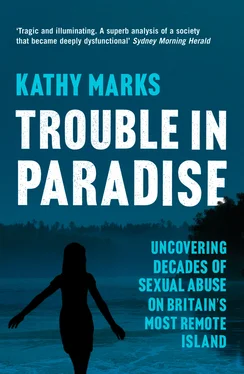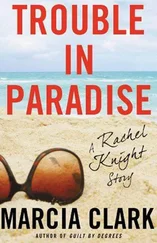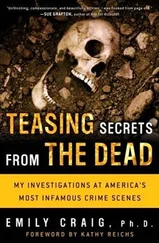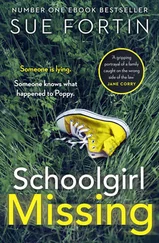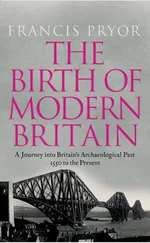In 1800 Young died from an asthma attack. It was ten years since the mutineers had first spied Pitcairn. Of the 15 men who had settled there, only Adams was left.
Carved into a cliff high above Adamstown is Christian’s Cave, reached by a vertiginously sheer trail trampled by the wild goats that roam the island’s ridges and escarpments. It was to this windblown spot, a dark slash in the volcanic rock face, that Christian would retreat, so it is said, to scan the Pacific Ocean for British naval ships—and to reflect, perhaps, on the reckless act that had exiled him for eternity.
Once the Bounty was stripped and burnt to the waterline, the mutiny stopped being Christian’s story. He was no longer a leader, and little is known about his life on Pitcairn, apart from the fact that his Tahitian wife—called Maimiti, or sometimes Mauatua—bore him two sons and a daughter. There is still debate about whether he really died there, or somehow managed to return to England—stoked by a ‘sighting’ of him in Plymouth, and the failure ever to locate his burial site.
The only mutineer with a preserved grave is John Adams, and it is he, not Christian, who was the father of the Pitcairn community, who set it on the course it was to follow for the next 200 years.
Adams, an ambiguous figure, signed up for the Bounty as Alexander Smith, reverting to his real name on the island. Rough and ready, like the average working-class salt, he played a prominent role in the seizing of the Bounty and subsequent racial warfare. Then, after the killings, he underwent a miraculous conversion—at least, that was his account, and there was no one left alive to challenge it.
Adams claimed that Edward Young taught him to read, using a Bible retrieved from the Bounty , and that he was so affected by the Bible’s teachings that he repented of his misdeeds and embraced Christianity. After Young’s death he was left alone with nine women and the 24 children born to the mutineers during those violent early years; strangely, no children were fathered by the Polynesian men. And, according to Adams, all of them led lives of spotless integrity under his patriarchal guidance.
The outside world, meanwhile, was gripped by the mystery of the mutineers’ whereabouts. The men on Tahiti had been quickly tracked down and shipped home, then court-martialled, after which three of them were hanged. Fletcher Christian and his followers, though, seemed to have vanished.
The little society headed by Adams lived in complete isolation until 1808, when an American whaler, the Topaz , stumbled across it; the Topaz ’s captain, Mayhew Folger, was astounded to be greeted by three dark-skinned young men in a canoe, all of whom spoke perfect English. Adams related his tale of sin and redemption to Folger who, after just a few hours on shore, left convinced that Pitcairn was ‘the world’s most pious and perfect community’. He informed the Admiralty about his incredible discovery, but the news was received with indifference; Britain was at war with France, and the mutiny was no longer of much interest in naval circles.
To each visitor after Folger, Adams gave a slightly different version of events, and few visitors interviewed the women, who were the only other witnesses. It was the start of the myth-making that was to obscure the reality of Pitcairn for the next two centuries.
By 1814 Adams was out of danger, following another chance visit, this time by two British naval captains. Enchanted by the new colony, they advised the Admiralty that it would be ‘an act of great cruelty and inhumanity’ to repatriate Adams and put him on trial.
Pitcairn’s period of seclusion was over. A stream of ships called, mainly British men-of-war, but also whalers and merchant vessels. All of them found a peaceful, devout society whose young people were healthy, modest and well educated. The legend of an island populated by reformed sinners, the offspring of murderers and mutineers, spread across the English-speaking world.
To outsiders, the idea of a Western-style community flourishing in such a faraway spot was compelling. Missionary groups dispatched crateloads of Bibles; other well-wishers, including Queen Victoria, sent gifts such as flour, guns, fishing hooks, crockery and an organ. Pitcairn was many things to many people. It was a religious fable. It was a fairy tale. It was the fulfilment of a Utopian dream.
The island’s fame grew in the late 19th century, after the locals rescued foreign sailors from a series of shipwrecks. Then in 1914 the opening of the Panama Canal put Pitcairn on the main shipping route to Australia and New Zealand. Liners packed with European emigrants would pause halfway across the Pacific so that their passengers could glimpse the island, and even meet its inhabitants, for—then as now—the islanders would board the ships to sell their souvenirs.
Jet travel destroyed the glamour of the ocean voyage, but while the rest of the world shrank, Pitcairn remained tantalisingly inaccessible, thus retaining much of its original allure. Children still scoured atlases for it; adults projected their escapist fantasies onto it; armchair travellers daydreamed about stepping ashore. The islanders, meanwhile, cultivated their own mystique, nurturing the romantic aura that drew tourists—and their American dollars—to their door.
The day after we arrived on Pitcairn, Olive Christian, Steve’s wife, invited members of the media to Big Fence, her sprawling home overlooking the Pacific. Like the rest of my colleagues, I had absolutely no idea what to expect.
When we got there in the early afternoon, 15 women—almost the entire adult female population—were assembled on sofas and plastic chairs arranged around the edge of the living room. The room, which had a lino floor, was as big as a barn; the walls were decorated with family photographs and a large mural of fish and dolphins. Through the front window we could see tall Norfolk pines clinging to slopes that tumbled steeply to the ocean.
The women represented all four of Pitcairn’s main clans: the Christians and Youngs, still carrying mutineers’ surnames, and the Browns and Warrens, descendants of 19th-century sailor settlers. The other English lines—Adams, Quintal and McCoy—had died out, although not in New Zealand or on Norfolk Island, 1200 miles east of Australia, where most people with Pitcairn roots now live.
At the time of the Big Fence gathering, the names of the seven Pitcairn-based defendants were still suppressed by a court order. However, we were privy to this poorly kept secret. Every woman in the room was related to one or more of the men—as a wife, mother, sister, cousin, aunt or stepmother-in-law.
Looking around, I saw that, with a few exceptions, the women were solidly built. While some were dark-haired, with striking Polynesian features, others, with their fair skin and European looks, would not have stood out in an English village. All of them were casually dressed, many in shorts and singlets: practical choices, given the heat and ubiquitous Pitcairn dust.
We had been summoned to Big Fence, it turned out, to be told that their menfolk were not ‘perverts’ or ‘hardened criminals’: they were decent, hard-working family types. No islander would tolerate children being interfered with, and no one on Pitcairn had ever been raped. The ‘victims’ were girls who had known exactly what they were doing. It was they who had thrown themselves at the men.
As I digested this notion, which was being put forward with some passion, I noticed that a handful of people were dominating proceedings. These particular women were speaking over the top of each other, impatient to get their point across. Others said little, and looked ill at ease. Steve Christian’s mother, Dobrey, sat quietly, weaving a basket from pandanus leaves.
Читать дальше
